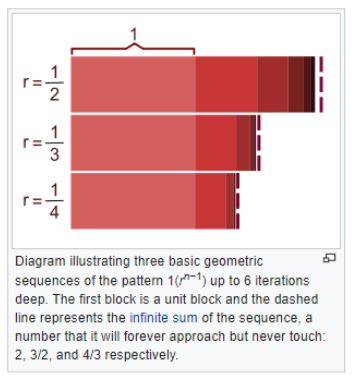
- What is Geometric progression?
- Weightage of Geometric Progression in Class 11
- Illustrated examples on Geometric Progression
- FAQs on Geometric Progression
What is Geometric progression?
An ordered collection of items or terms is known as a sequence. A sequence that follows a specific pattern is known as a progression. The numbers that occur in a sequence are terms of the sequence. Geometric progression (GP) is a sequence where the terms follow a pattern. Each succeeding term is the product of its preceding term and a fixed number, the common ratio.
If a sequence g1, g2, g3,...gn is a GP, then-
gn+!/gn= r,
where all the terms are non-zero and n ≥1.
Here, r is constant and is known as the common ratio.
Consider g1= g; we get the GP:
g, gr, gr2, gr3…,
where g is the first term, and r is the common ratio of the GP.
The general term of a GP:
Consider a GP with the first non-zero term ‘g’ and common ratio ‘r’. To obtain the second term, multiply g with r, thus g2 = gr.
Similarly, to obtain the third term multiply g2 with r. Thus, g3 = g2 r = gr2 , and so on.
Therefore, the pattern suggests that the nth term of a G.P. is given by:
gn= g.rn-1
Thus, G.P. can be written as g, gr, gr2,gr3, …,g.rn-1
The sum of terms of a GP:
If the first term of a GP is g and the common ratio is r, then Sn is the sum to first n terms of G.P.
Sn= g+ gr+ gr2+gr3 +, …grn-1
If we consider r=1, then the above equation becomes:
Sn= g+g+g+g… n times= ng.
If n≠1, we multiply r with the earlier equation
rSn= gr+ gr2+gr3 +, …grn.
On subtracting this equation from the above equation, we get
(1-r) Sn= g- grn= g(1- rn)
The sum of n terms of a GP is given by:
Sn= {g(1- rn)}/ (1-r)
Weightage of Geometric Progression in Class 11
GP is a part of the chapter ‘Sequence and Series’ in Class 11th maths. It carries a weightage of around 4-5 marks in the exams.
Illustrated examples on Geometric Progression
1. In a G.P., the 3rd term is 24, and the 6th term is 192. Find the 10th term.
Solution.
g3= 24= gr2
g6= 192= gr5
g6/ g3= 192/ 24=> r3.= 8, so r=2.
Placing the value of r in the first equation, we get
g3= 24= gr2 => g(2)2= 24 => g= 24/4 = 6
Hence, g10= gr9= 6 x (2)9= 3072.
2.A person creates a pattern with marbles such that the first line has 2 marbles, then 4, then 8, and so on. Find the total number of marbles required to make this pattern in ten lines.
Solution.
Here, first term= g =2 and r=2, n=10
Sn= {g(rn- 1)}/ (r- 1)
Sn= {2 (210-1)}/(2-1)
Sn= 2 x (210-1) =2046.
3. In the GP 2,8,32, ... up to n terms, which term is 131072?
Solution.
In the given GP, gn= 131072
First term= a= 2, r= 8/2= 4
gn = arn-1. => 131072= 2 x 4n-1 => n= 9.
FAQs on Geometric Progression
Q: What is the difference between an arithmetic progression and a geometric progression?
Q: What is the common ratio of a GP?
Q: What is the general term of a GP?
Q: What is the sum of m terms of a GP?
Q: What is the geometric mean of two numbers?
Maths Sequence and Series Exam
Student Forum
Popular Courses After 12th
Exams accepted
CA FoundationExams accepted
ICSI ExamExams accepted
BHU UET | GLAET | GD Goenka TestBachelor of Business Administration & Bachelor of Law
Exams accepted
CLAT | LSAT India | AIBEExams accepted
IPMAT | NMIMS - NPAT | SET
Exams accepted
BHU UET | KUK Entrance Exam | JMI Entrance ExamBachelor of Design in Animation (BDes)
Exams accepted
UCEED | NIFT Entrance Exam | NID Entrance ExamBA LLB (Bachelor of Arts + Bachelor of Laws)
Exams accepted
CLAT | AILET | LSAT IndiaBachelor of Journalism & Mass Communication (BJMC)
Exams accepted
LUACMAT | SRMHCAT | GD Goenka Test

